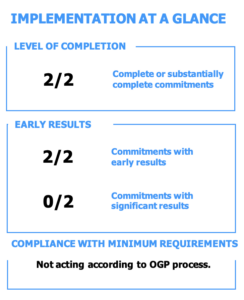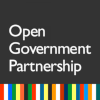Estonia Results Report 2022-2024
- Action Plan: Estonia Action Plan 2022-2024
- Dates Under Review: 2022-2024
Estonia’s sixth OGP action planAction plans are at the core of a government’s participation in OGP. They are the product of a co-creation process in which government and civil society jointly develop commitments to open governmen... improved the framework for co-creative and evidence-based policymaking within the public sector. While civil society organizations actively contributed to action plan implementation, opportunities remain to improve the depth and timeliness of government feedback. The Government Office’s central role effectively supported commitmentOGP commitments are promises for reform co-created by governments and civil society and submitted as part of an action plan. Commitments typically include a description of the problem, concrete action... ambitionAccording to OGP’s Articles of Governance, OGP commitments should “stretch government practice beyond its current baseline with respect to key areas of open government.” Ambition captures the po... and completionImplementers must follow through on their commitments for them to achieve impact. For each commitment, OGP’s Independent Reporting Mechanism (IRM) evaluates the degree to which the activities outlin... More levels. However, broadening the circle of government implementers could help build stronger ownership of future OGP action plans.

Early Results
Both commitments identified as promising in the Estonia’s 2022–2024 Action Plan Review achieved moderate early resultsEarly results refer to concrete changes in government practice related to transparency, citizen participation, and/or public accountability as a result of a commitment’s implementation. OGP’s Inde... More during implementation.
Estonia’s sixth OGP action plan advanced both public participationGiving citizens opportunities to provide input into government decision-making leads to more effective governance, improved public service delivery, and more equitable outcomes. Technical specificatio... and government transparencyAccording to OGP’s Articles of Governance, transparency occurs when “government-held information (including on activities and decisions) is open, comprehensive, timely, freely available to the pub... More. It spurred significant advances in evidence-based policymaking (Commitment 2) with the government developing user-friendly guidelines for structured policy experiments, training public officials, and funding projects that foster experimental public sector innovation. It also paved the way for improvements in public participation (Commitment 1) by bringing government and civil society together to create an open government roadmap that offers concrete solutions to current problems in public participation.
Completion
The action plan contained five activities, clustered into two commitments. One sought to foster public participation in policy making, and the other sought to strengthen evidence-based policymaking. As with previous action plans, most activities were either fully or substantially completed. Successful activities, such as the creation of a framework for experimental policy making (Activity 2.1) were characterized by a holistic approach to changing public governance practices. Meanwhile, the development of an open government roadmap (Activity 1.2), while substantially completed, could benefit from a more robust implementation mechanism to ensure the sustainability of its outcome.
While ambitious in their long-term vision, commitments involving the development of digital tools did not achieve notable results during this action plan cycle. The public interface for a new digital policy co-creation tool (Activity 1.1) faced delays extending beyond the action plan cycle,[1] while the data-driven decision support system (Activity 2.2) remained in a prototyping stage, which, at the time of review, leaves its impact on government transparency uncertain.
Participation and Co-Creation
The Government Office continues to oversee the OGP process in Estonia. The Open Government Development Committee (ARVAK) acts as a multi-stakeholder forumRegular dialogue between government and civil society is a core element of OGP participation. It builds trust, promotes joint problem-solving, and empowers civil society to influence the design, imple... (MSF) where government and civil society organizations (CSOs) jointly monitor action plan development and implementation. Civil society actively participated in the implementation of all commitments, with the scope and depth of participation varying. It ranged from occasional consultations to significant contributions towards implementation.
The government regularly updated CSOs on implementation progress throughout the action plan cycle. However, in the period before and after the OGP Global Summit in September 2023 (May 2023-February 2024), there were no meetings between government and civil society to discuss action plan implementation. Overall, civil society stakeholders would like to have received more in-depth and timely information during commitment implementation. They also noted that active engagement in MSF activities could be strengthened. Beyond the action plan, the government worked closely with civil society to design the agenda for the 2023 OGP Global Summit, inviting CSOs to organize their own events.
Implementation in context
Key highlights of the 2022–2024 action plan period included Estonia’s co-chairing of the OGP Steering Committee and hosting of the OGP Global Summit in Tallinn in September 2023. According to the Government Office, organizing the summit was the most time- and resource-intensive activity in the action plan cycle.[2] However, with the two commitments mostly led by the Government Office, coordination during the implementation stage required minimal effort, which helped them complete most of the milestones.[3]
Estonia’s success in implementing the commitments was enabled by the availability of funding, with the majority of activities financed through the European Union’s Cohesion Policy funds. Meanwhile, the rapid development of large language models and generative AI further shaped the technological direction of the government’s data-driven decision support tool (Activity 2.2).
Although Estonia held parliamentary elections in 2023, the political changes did not affect action plan implementation.[4] However, the elections led to an almost year-long parliamentary deadlock.[5] In response, the government expedited the drafting of new bills at an unprecedented speed, setting extremely short deadlines for stakeholder consultations. Collectively, these circumstances undermined Estonia’s own standards for good legislative practices and public participation.
[1] Kristina Liik (Project Manager, Government Office) and Karmen Vilms (Product Owner, Ministry of JusticeTo address barriers that prevent citizens from having their justice needs met, OGP participating governments are working to expand transparency, accountability, and inclusion into all systems of justi... and Digital Affairs), interview by IRM researcher, 23 January 2025.
[2] Ott Karulin (Former OGP Point of Contact, Government Office), interview by IRM researcher, 10 December 2024.
[3] Karulin, interview.
[4] Karulin, interview.
[5] Madis Hindre, “Coalition breaks Riigikogu filibuster for first time,” Estonian Public Broadcasting, 18 April 2024, https://news.err.ee/1609316562/coalition-breaks-riigikogu-filibuster-for-first-time.

Leave a Reply